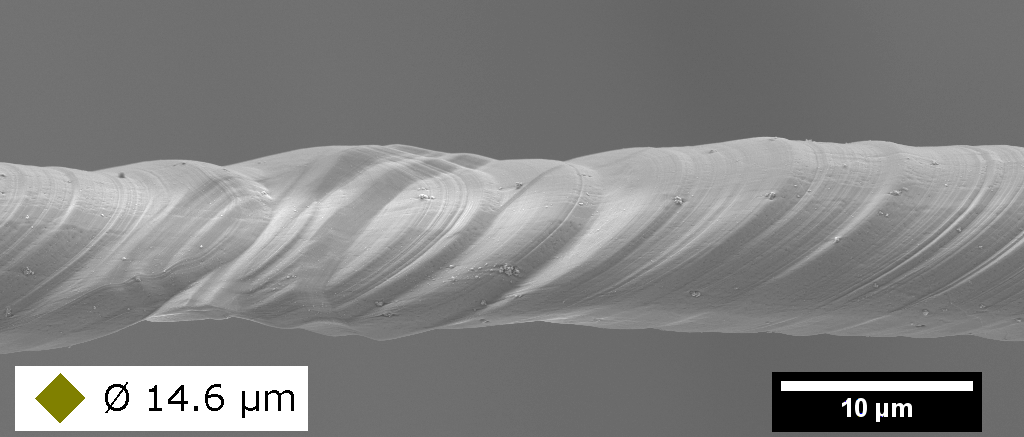Cast aluminium microfibres
Suzanne Verheyden, Léa Deillon and A. Mortensen (with former contributions from Jérôme Krebs and Csilla Miko)
This project funded by the Swiss National Science Foundation aims for the development of processes enabling the net-shape casting of metallic samples on the scale of one to one hundred micrometres, and their use towards the exploration of the plasticity size effect in metals and alloys.
Precision casting involves the production, using solid patterns and lost wax, of shaped pores within a mould of material sufficiently refractory and chemically inert to contact molten metal. If the mould material can further be made water soluble and if pressure can be applied on the metal to force it into pores finer than gravity alone will allow, then shaped castings can be made much smaller than is currently achieved using conventional technology; this is the approach explored in this project to push to finer dimensions the art of casting. Specifically, we have developed carbonate-based moulding compounds for the production of shaped copper castings a few hundred micrometres wide. In recent work, NaCl moulds have been produced into which straight cylindrical fibres of aluminium around 10 µm in diameter and of surface roughness on the order of 50 nm have been cast. These metal wires are single-crystalline and free of defects such as those introduced by alternative techniques such as focused ion beam machining. We are currently testing these wires in tension to explore their plastic deformation and its dependence on the diameter of the wire, using a custom-built microsample tensile testing apparatus.


For more information please refer to:
Please note that the publication lists from Infoscience integrated into the EPFL website, lab or people pages are frozen following the launch of the new version of platform. The owners of these pages are invited to recreate their publication list from Infoscience. For any assistance, please consult the Infoscience help or contact support.
Laue microdiffraction characterisation of as-cast and tensile deformed Al microwires
Philosophical Magazine. 2019-04-17. p. 185503. DOI : 10.1080/14786435.2019.1605220.Please note that the publication lists from Infoscience integrated into the EPFL website, lab or people pages are frozen following the launch of the new version of platform. The owners of these pages are invited to recreate their publication list from Infoscience. For any assistance, please consult the Infoscience help or contact support.
The effect of size on the plastic deformation of annealed cast aluminium microwires
Scripta Materialia. 2019-03-01. Vol. 161, p. 58-61. DOI : 10.1016/j.scriptamat.2018.10.009.Please note that the publication lists from Infoscience integrated into the EPFL website, lab or people pages are frozen following the launch of the new version of platform. The owners of these pages are invited to recreate their publication list from Infoscience. For any assistance, please consult the Infoscience help or contact support.
Stress relaxation in the presence of sudden strain bursts: Methodology and stress relaxation data of microcast aluminium microwires
Data In Brief. 2018-12-01. Vol. 21, p. 2134-2141. DOI : 10.1016/j.dib.2018.11.047.Please note that the publication lists from Infoscience integrated into the EPFL website, lab or people pages are frozen following the launch of the new version of platform. The owners of these pages are invited to recreate their publication list from Infoscience. For any assistance, please consult the Infoscience help or contact support.
Thermal Activation, Intermittency and Size Effects in the Plastic Deformation of Cast Aluminium Microwires
Lausanne, EPFL, 2018.Please note that the publication lists from Infoscience integrated into the EPFL website, lab or people pages are frozen following the launch of the new version of platform. The owners of these pages are invited to recreate their publication list from Infoscience. For any assistance, please consult the Infoscience help or contact support.
Cast aluminium single crystals cross the threshold from bulk to size-dependent stochastic plasticity
Nature Materials. 2017. Vol. 16, p. 730–736. DOI : 10.1038/nmat4911.Please note that the publication lists from Infoscience integrated into the EPFL website, lab or people pages are frozen following the launch of the new version of platform. The owners of these pages are invited to recreate their publication list from Infoscience. For any assistance, please consult the Infoscience help or contact support.